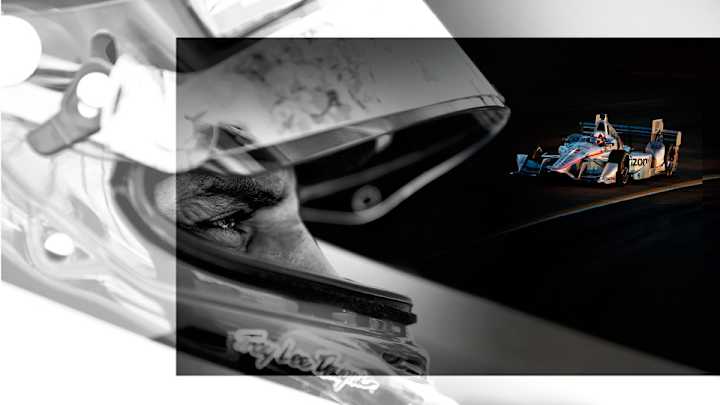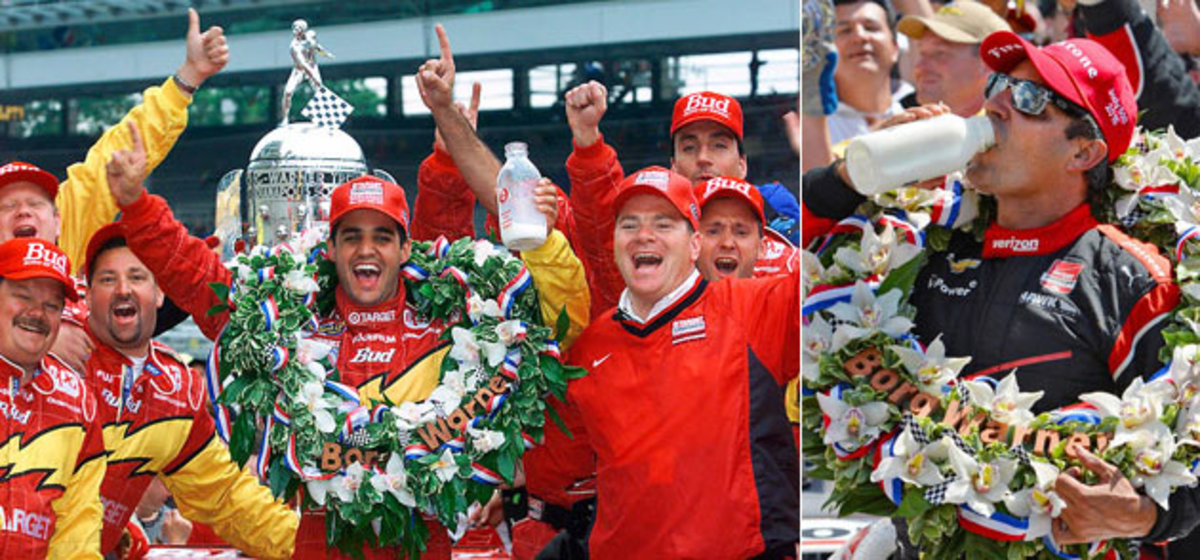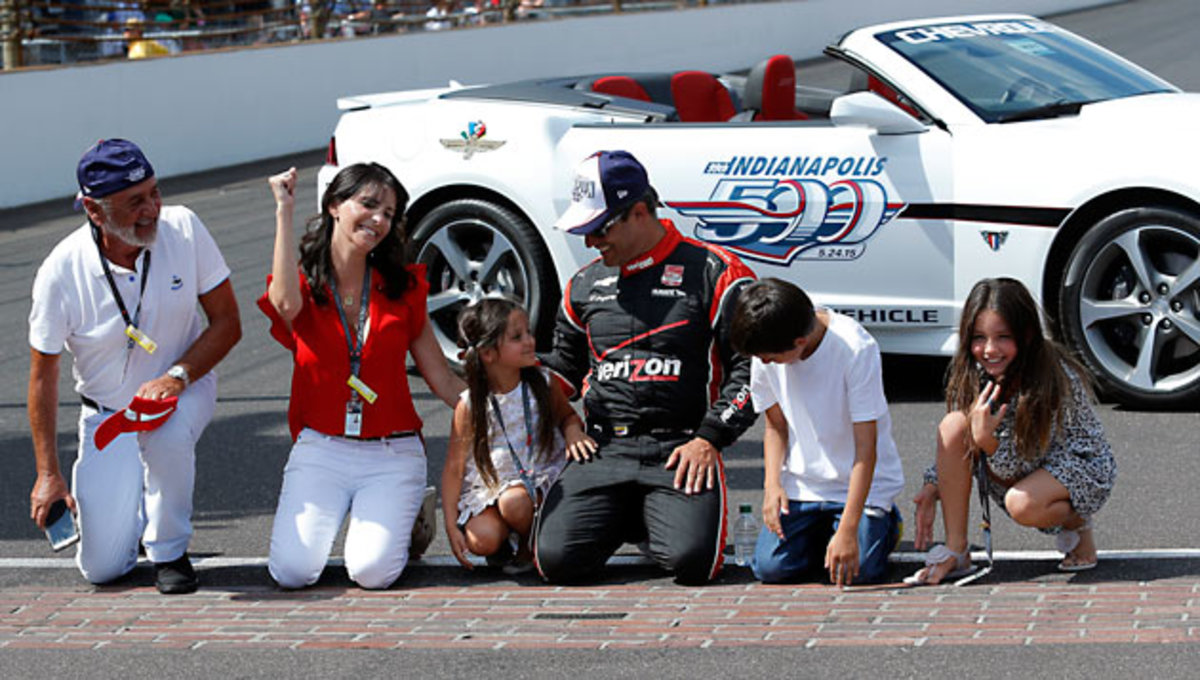Racer's Edge: Juan Pablo Montoya isn't here to make friends

This story appeared in the May 23, 2016 issue of SPORTS ILLUSTRATED. To subscribe, click here.
Get all of Andrew Lawrence’s columns as soon as they’re published. Download the new Sports Illustrated app (iOS or Android) and personalize your experience by following your favorite teams and SI writers.
A scorching afternoon last month at Phoenix International Raceway found Juan Pablo Montoya inside his cool, dark Team Penske transporter, holding forth on the subject of radio-control aircraft. They have been his obsession for 16 years, or about as long as the 40-year-old Colombia-born IndyCar veteran has been recognized as an ace racing pilot—give or take that eight-year NASCAR odyssey.
Montoya was hooked from the first toy, a Christmas gift—a sailplane with a 19-foot wingspan. Its $300 price tag seems quaint now compared with the five figures he often drops on one these days. Montoya admits that three weeks before this desert trip, at IndyCar’s season opener in St. Petersburg, Fla., his first instinct after dusting the field was to take his share of the $80,000 winner’s check and head to the nearest hobby shop. Oooh, he thought while streaking toward the finish, I’m ordering a new F-18!
The whole fleet—more than two dozen planes, gliders, helicopters and drones—fills a warehouse near Montoya’s Miami home, with plenty of surrounding airspace for him to exercise his skills. And those skills, he stresses, do not depend on the many modern electronic aids that can make flying these planes child’s play. This clarification is typical of Montoya—who is, refreshingly, one of the few personalities left in racing who can’t remotely be controlled.
So what if his point seems obvious to anyone who’s seen him handle his workaday craft? That race in St. Pete? Montoya won even after the steering arm broke on his Chevy-powered number 2 Verizon Penske machine. He considered making more of that problem at the time, but why? He had someplace to be.
It’s no wonder Montoya would gravitate toward RC flying, a hobby that affords him all the space and time that racing doesn’t. There’s also some assembly required. He spent countless hours over eight months on his latest project, a Corsair with a seven-foot wingspan. But just when it seems as though his hobby couldn’t possibly leave the married father of three with any focus left for his day job, Montoya—fresh from qualifying for the Desert Diamond West Valley Phoenix Grand Prix, incidentally—swivels to look over his left shoulder toward a window. As race cars roar past he peeks at the scoring pylon to check his qualifying position, which holds for third on the starting grid, two spots behind teammate Hélio Castroneves. Then, on cue, team owner Roger Penske, aka the Captain, bursts into the transporter, and Montoya greets him with a cheerful, “Good job, boss!”
“Yeah,” Penske says, “that was a good job.”
Montoya breaks the mold of today's p.r.-programmed automaton drivers.
A strong finish here would augur well for the points championship race, which Montoya lost last year on a tiebreaker in the season finale at Sonoma. He might have brooded over that near miss longer, he insists, had he not won the Indianapolis 500 three months earlier.
Think he’s bluffing? Hang on as he swivels over his right shoulder this time and calls the Captain for backup.
“RP?” Montoya hollers to Penske, now in the next room.
“Yeah?”
“Will you take the championship or the Indy 500?”
“I would much rather win Indy 16 times than the championship 16 times.”
A smile creases Montoya’s face. “You see?”

THAT SUPREME sense of certainty is a good part of why Montoya looks primed to visit Victory Circle again on May 29, in the 100th running of the Indianapolis 500. Of course he draws another boost from Team Penske, an outfit with a record 16 Borg-Warner trophies (if you didn’t catch the Captain’s drift earlier) that had Montoya sitting third in points as of May 16.
Since Montoya joined the franchise almost 2-1⁄2 years ago, few drivers have won more races (four) or averaged a higher finish (8.0). “I never had any doubt he’d be competitive out of the box,” says Mario Andretti, the only driver who can top the Colombian’s interdisciplinary résumé—which, in addition to NASCAR, also includes stops in the bygone CART series (1999 and 2000) and Formula 1 (from ’01 through ’06).
The stiffest challenge to Montoya’s quest to repeat will likely come from his fellow Penske drivers: points leader (and winner of the last three races) Simon Pagenaud, a Frenchman who had a real shot at the Borg last year until late aerodynamic damage; Australia’s Will Power, the 2014 IndyCar series champion, who finished .105 seconds behind Montoya in the ’15 race; and the Brazil-born Castroneves, a three-time 500 winner. And even then Montoya should be able to count on their cooperation for most of the 200-lap race.
Montoya can also expect pressure from the Ganassi team, the only shop besides Penske’s to win this season. In particular, Ganassi’s ace, Scott Dixon of New Zealand, who started last year’s race on pole and appeared set to battle Power down the stretch. That is, until Montoya stormed from the back of the pack and passed them both on the way to grabbing his second Brickyard checkered flag—15 years after his first. That 2000 victory, as a 24-year-old CART newbie, brought him a celebrity in his homeland to rival that of the biggest stars on the national soccer team. “Probably everyone [in Colombia] who’s ever seen a TV in their life knows who Juan Pablo is,” says Gabby Chaves, a 22-year-old from Bogotá who was named IndyCar’s rookie of the year in 2015.
In victory last year Montoya once again proved himself a different breed of wheelman, one who can lift a team, no matter how sideways things get. At Indy, where chaos is the only constant, that’s a trait that trumps, say, personal charm.

MONTOYA IS often described as prickly—a word that captures more than just his stubbly chin, his quilled salt-and-pepper coif, and the sharp-elbowed aggression with which he buzzes around a speedway. It also neatly sums up a man who will roll his eyes as much as he does his r’s over any distraction from his core mission: being the fastest guy on the track. Autograph seekers, whether they’re in a formal queue behind the Penske transporter or happen upon Montoya at the mall, are not easily suffered. That goes double for members of the media. Sniff around for deep introspection, and Montoya hits the brakes.
Ask him about that time in 1995 when he landed in London to jump-start his racing career in F1 and was strip-searched by Heathrow Airport customs officials (who perhaps had visions of Pablo Escobar as they happened upon this fresh arrival from Bogotá), and Montoya shrugs. “It is what it is,” he says. “I didn’t care.” Ask him if he takes satisfaction in seeing so many Latin American drivers in NASCAR, or if he feels pride at having paved the way in IndyCar for two other bogotanos (Chaves and Andretti’s Carlos Muñoz), and Montoya scoffs. “People don’t understand that I’m not in this sport to change anything,” he says. “I don’t give two f---- about changing anything. I’m here to win races.”
Montoya’s grouchiness might be unbearable if it wasn’t grounded in honesty, or if he didn’t wield it to challenge the status quo. After last year’s race at Fontana, a hectic affair that featured several spectacular crashes, Montoya called the aero package dictated by IndyCar “insane” and urged officials to make immediate adjustments. Depending on how long you’ve been following racing, he either breaks the mold of today’s p.r.‑programmed automatons or harks to the days when guys like A.J. Foyt got right to the point. “He’s like that, yeah,” says Power. “Very blunt. Doesn’t screw about.”
“Yeah, he’s unfiltered and he’s brash,” says Brian Campe, Montoya’s race engineer and closest collaborator, “but that’s actually great for what I do. I don’t ever have to go, What did he really mean? He has the perfect lens for the problem and can guide me to where I need to look to make the fix. If he has the confidence in the car that he needs, we’re gonna win. Weekends are easy.”

FEW WOULD have pegged these two as a future power couple some three years ago. Montoya, then driving in NASCAR for Ganassi, was in a lame duck contract year and contemplating retirement when Penske team president Tim Cindric approached him about manning an expansion fourth IndyCar team. They agreed to a deal before securing any sponsorship around Montoya—a cart-before-the-horse tack rarely taken in these tough economic times. “We gambled a bit,” says Penske. “But knowing him as a friend, I knew that he’d also bring some fire into the team and push our guys.”
Meanwhile, Campe, a NASCAR lifer, was overseeing one of Penske’s Nationwide teams when Cindric persuaded him to join the new IndyCar team as an assistant race engineer. After helping Montoya to four podiums (including a win at Pocono) in 2014, Campe was promoted and, the very next season, had the team leading the championship. The bottom didn’t fall out until the last 20 laps of the ’15 series finale, when Dixon surged to the front and never looked back. That checkered flag drew the Kiwi even with Montoya in points while furnishing him with a third race win to Montoya’s two—the difference that settled the score.
During the off-season Campe went through every radio conversation the team had in search of lessons. “What I heard was over the first half of the season we were super aggressive, then all of a sudden we started letting everybody back into the game,” he says. “The plan this year is to stay the aggressor. And if we lose the championship going for wins, I don’t think anyone’ll be disappointed.”
That tone was on clearest display at last year’s Indy 500. As Montoya took a first swig from the traditional bottle of milk and then drew his son, Sebastian, in close for a taste, it was easy to see how far this seemingly washed-up Cup racer had come.
MONTOYA'S DECISION to race in NASCAR was guided by a desire to stay close to his growing family. In 2001, when he jumped to Formula 1 after a two-year stint in CART that saw him win a quarter of the races he entered, the 25-year-old Montoya was an anomaly among the jet set—an introvert who’d rather be at home hunched over an RC plane than, say, working a red carpet. To remain close to their extended families, he and Connie, a law student from Colombia, made their home in Miami, an ocean away from F1’s Europe-based community. By the fall of 2006 they were parents to Sebastian (now 11); then came daughters Paulina (nine) and Manuela (five). NASCAR Country, where million-dollar RVs and infield playgrounds provide a sense of home, seemed far more conducive to family life than F1—where the jet lag is real.
Actually, the F1 travel might have been tolerable if the intrateam politics hadn’t been so contentious. “You can do all the work you want,” says Montoya, who considered retiring after a six-year F1 stint that produced 30 podiums, seven of them victories. “But if [your team owners] decide to put the new parts on [your teammate’s] car, you gotta move out of the way.”
When Montoya’s old CART team boss, Chip Ganassi, offered him a NASCAR ride, the driver seized it with the intent of elevating Ganassi’s underdog stock car program to the level of its dynastic IndyCar franchise. Little did he know the new burdens that would be on him.
For starters there was the bigger car—too ponderous for Montoya to stick into any gap, as had long been his open-wheel habit. So he wrecked a lot more and, as consequence, earned a reputation as a rolling hazard. “In NASCAR,” explains Michael Andretti, the former open-wheel ace turned IndyCar team owner, “you’re anticipating when things are gonna happen.” To Montoya this felt too much like “driving a bus.”
Then there was NASCAR’s other baggage, which make the behind-the-scenes infighting of F1 seem picayune. In addition to the economic realities that saw the deepest-pocketed franchises holding a monopoly on winning, NASCAR insisted on marketing Montoya as a diversity poster boy—the dashing star from Bogotá who would usher in a new wave of Latin American fans in the U.S. It hardly mattered that the rabid support he enjoyed in his homeland evaporated as soon as he left F1.
“They took it personally,” says Connie of the many Colombians who saw Montoya’s move as like going from sipping champagne to shotgunning beers.
Offers Chaves, the young IndyCar standout, “As a group, I think Colombians are very much driven by success rather than participation.”
"I come every week to make sure that I can beat the hell out of everybody."
OUTSIDE OF nine Cup poles, two wins and a Chase berth in 2009, Montoya enjoyed little success racing stock cars. In ’13 he was about ready to retire again; the difference this time is that he would have been entirely justified staying parked. Montoya was hurtling toward 40, an age where many drivers start thinking about yielding to burnout—especially if, like Montoya, they won a national karting championship at age six.
But in IndyCar, Montoya has caught an unlikely third wind. The work environment at Penske has been uplifting, not least because the owner’s ego is big enough to keep those of his drivers in check. And the schedule, which features half as many dates as the NASCAR calendar, helps keep Montoya fresh. “I remember sitting at home going, Oooh, I’m not traveling this week,” Montoya says. “What am I gonna do?” Go flying. Help Sebastian with his karting. Play hide and seek with the girls. Either way, he’s making good times.
With his reputation in the cockpit redeemed and no one left to please but himself and the Captain, Montoya is racing with a jet stream at his back. It could be a while yet before he finds his way back down to Earth. “I come every week to make sure that I can beat the hell out of everybody,” he says. “The day I don’t feel I wanna do that, I’ll walk away. Simple.
